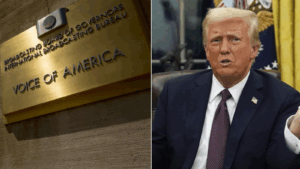After years of opposition to the 2015 nuclear agreement between Iran and the Obama administration, Saudi Arabia is showing optimism toward the potential revival of a similar deal under the Trump administration.
Saudi Arabia Shifts Stance on Iran Nuclear Talks Amid Regional Change

Saudi Arabia Shifts Stance on Iran Nuclear Talks Amid Regional Change
In a surprising turn of diplomatic events, Saudi Arabia now appears to support ongoing U.S. negotiations with Iran, marking a shift from its previously critical stance.
As Saudi Arabia's relations with Iran warm, fueled by a desire for regional stability and economic diversification, the dynamics surrounding nuclear negotiations have transformed dramatically.
Saudi Arabia, traditionally wary of Iranian influence, previously condemned the landmark deal struck between the Obama administration and Iran, labeling it ineffective and dangerous—believing it only strengthened the Iranian regime. The Saudi government celebrated when President Trump pulled the U.S. out of the agreement in 2018, prompting a recalibration of alliances and strategies in the Middle East.
However, the tide seems to be shifting. Recently, the Saudi Foreign Ministry expressed hope that renewed negotiations—facilitated by Oman—would contribute positively to peace not just in the region, but globally. The Crown Prince of Saudi Arabia, Mohammed bin Salman, surprisingly sent his brother, Defense Minister Prince Khalid bin Salman, to Tehran where he was met with courtesy by Iranian officials—a far cry from prior hostility. During this meeting, Prince Khalid handed a letter from the Crown Prince to Iran's Supreme Leader, Ayatollah Ali Khamenei, marking a significant thaw in relations.
What has driven this transformation? Analysts suggest that Saudi Arabia's aim to diversify its economy away from oil dependency has factored significantly into its new approach towards Iran. As the kingdom strives to become a major business and tourism hub, the fear of regional conflicts exacerbated by Iranian military capabilities, such as drones and missiles, poses a direct threat to these aspirations.
Overall, this evolving relationship between Saudi Arabia and Iran highlights the shifting sands of Middle Eastern diplomacy and presents a nuanced backdrop against which ongoing nuclear negotiations unfold.
Saudi Arabia, traditionally wary of Iranian influence, previously condemned the landmark deal struck between the Obama administration and Iran, labeling it ineffective and dangerous—believing it only strengthened the Iranian regime. The Saudi government celebrated when President Trump pulled the U.S. out of the agreement in 2018, prompting a recalibration of alliances and strategies in the Middle East.
However, the tide seems to be shifting. Recently, the Saudi Foreign Ministry expressed hope that renewed negotiations—facilitated by Oman—would contribute positively to peace not just in the region, but globally. The Crown Prince of Saudi Arabia, Mohammed bin Salman, surprisingly sent his brother, Defense Minister Prince Khalid bin Salman, to Tehran where he was met with courtesy by Iranian officials—a far cry from prior hostility. During this meeting, Prince Khalid handed a letter from the Crown Prince to Iran's Supreme Leader, Ayatollah Ali Khamenei, marking a significant thaw in relations.
What has driven this transformation? Analysts suggest that Saudi Arabia's aim to diversify its economy away from oil dependency has factored significantly into its new approach towards Iran. As the kingdom strives to become a major business and tourism hub, the fear of regional conflicts exacerbated by Iranian military capabilities, such as drones and missiles, poses a direct threat to these aspirations.
Overall, this evolving relationship between Saudi Arabia and Iran highlights the shifting sands of Middle Eastern diplomacy and presents a nuanced backdrop against which ongoing nuclear negotiations unfold.






















